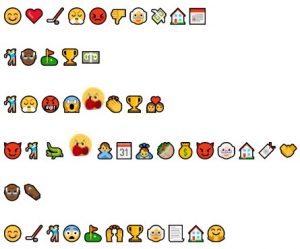Emojis are a shortcut to informal expressions of thoughts and feelings, but be careful how you use them because the result may have unintended consequences! This is an attempt to use emojis in a context for which they were not intended, but also without the familiar, standard decontextualized connotations of fruits and vegetables.
TITLE

PLOT

Combining knowledge of a movie from the 1990s and emoji literacy is not a simple task for a person that conventionally avoids the use of emojis and who is generally aware of their subverted uses and subsequent pitfalls. This reflection would not be complete if I left out the feeling of dread of attempting something that I openly resist in day-to-day personal and business communications; and that is why I accepted the challenge.
I started with the title. It seemed like it would be an easy win for a tyro. Relying on the concept of the film, on character, and plot became immediately necessary to create something descriptive enough to hint at the title. Why immediate? Proper nouns and pronouns are not in emoji form. What then is possible? What material is available to work with? Buchholz (2020) writes that there were 3,136 emojis available on devices in 2020 and that we can expect 3,353 by the end of 2021. That seems sufficient.
Bolter (2001, p. 73) describes a scenario where writers of prose exploit decontextualization and produce polyvocal texts in order to manipulate their reader’s perspectives. My aim was to produce as literal a 1:1 representation of the title and plot as I could muster, not to interpret language unless it became necessary. Can emojis help to create the univocality that I seek and under the same conditions that Bolter writes about regarding icons? I started with an assumption that the standardization of emoji’s would help, but what I found even with the creation of the title is the potential emergence of idiolects by people and cultures that create new interpretations and meanings derived from original ideas and transformed into something else. I preferred to avoid the consequences of the produce section, and simply tried to standardize my own use of emojis throughout the plot description.
These icons (emojis) are quite flexible and are not designed to fix authorial intent as Bolter describes. One or two emojis combined can create complete sentences. With text-based emoticons, meaning is entirely the function of the shape (think semi-colon plus hyphen plus closed bracket to represent wink-nose-smile). Emojis are pictograms and seem to transform the movie plot into visual poetry. While the original media was a form of visual representation, the expressed ideas were not intended to be reduced to poetry. Not relying on syllables, I attempted to reduce the plot to the simplest set of icons and while working out the structure nearly created a haiku (too many parts and images).
What are the affordances of emojis? They are a convenient shorthand for people using mobile devices, are in transit, or short on time. Can they be used as features in a revised grammar the way Kress describes pitch-variation, syntax, vowel quality, energy variations, lexis, or textual organization (2005, p. 12)? They can share common features or stand alone, but are they as diverse and complex as a language? I did not get the impression that I was able to break the mould of literary convention and express with images exactly what I wanted, contrary to Kress’s remark (p. 15) that this can be so. The avoidance of emojis in chat and email leave the impression that this writer is conventional, and I would agree. I leaned heavily on an ability to read a poem more than an ability to represent the movie visually with emojis. Meaning and subjectivity, tone, mood, pace, syntax, rhythm, meter, and then an exploration of images that might be used to describe the main characters and rewrite the plot. Emoji-mediated language use for this context seems less concise to me than the written or spoken word.
Bolter, J. D. (2001). The Breakout of the Visual. In Writing space: Computers, hypertext, and the remediation of print (2nd ed.). Mahwah, N.J: Lawrence Erlbaum Associates. doi:10.4324/9781410600110
Buchholz, K. (2020). In 2021, Global Emoji Count Will Grow to 3,353. Statista, September 25, 2020. Retrieved from https://www.statista.com/chart/17275/number-of-emojis-from-1995-bis-2019/
Kress (2005), Gains and losses: New forms of texts, knowledge, and learning. Computers and Composition, Vol. 2(1), 5-22. doi.org/10.1016/j.compcom.2004.12.004